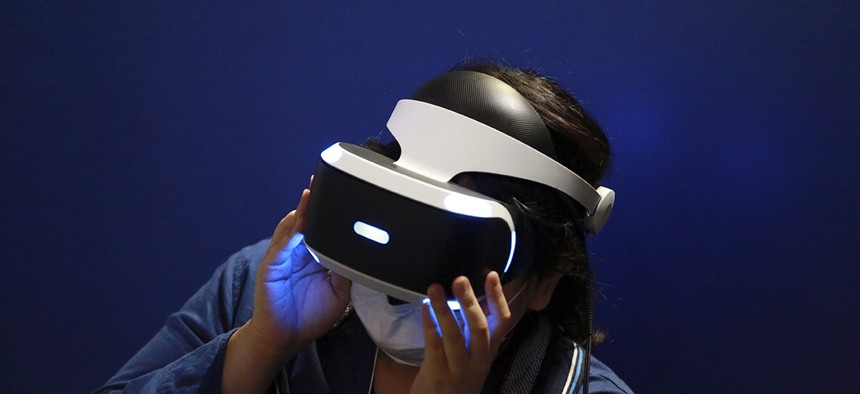What If Virtual Reality Can Make Us Better Citizens?

A visitor tries out a Sony's PlayStation VR headgear device at the Tokyo Game Show in Makuhari, near Tokyo. Eugene Hoshiko/AP File Photo
Researchers are studying how the technology can help us build empathy and change our personal behavior.
Last weekend, at a museum exhibition, I strapped on a virtual reality headset that blotted out the world around me. I couldn’t hear shoes scuffing cobblestones outside the window. All I could see was a long, wooden boat slicing through rippling water, below houses propped up on stilts. My body had melted away—I kept looking for my hands, and couldn’t find them. But I thought I could feel the breeze rustling my hair, and water droplets polka-dotting my arms. When I peeled off the mask, blinking into the afternoon light, the streets didn’t feel any more or less real than the boat and the ocean.
That’s a hallmark of the technology—it’s capable of giving users simulated experiences that generate real emotional reactions. Several researchers are now trying to harness that power to nudge human behavior for the better.
A new study published in the Journal of Computer-Mediated Communication suggests that immersive digital environments can stoke users’ sense of connection with nature—the implication being that empathizing with the natural world could potentially make humans better stewards of it.
This new project, conducted by researchers from the University of Georgia, Stanford, and the University of Connecticut, aimed to see whether VR could help users empathize with animals’ experiences. In the first experiment, the collaborators asked participants to model a cow, crawling on their hands and knees, stooping to eat and drink water before being prodded into a vehicle to transport them to the slaughterhouse.
The second experiment recreated the sensation of coral dying in an acidifying ocean. To create an immersive experience, participants felt vibrations in the floor and heard cracking sounds as the coral’s branches broke off. The researchers found the VR participants empathized with the scenarios more than a control group watching a similar experience on video.
“The studies reported here take the investigation of perspective taking to a new level by allowing participants to go beyond imagining the perspective of the cow or coral,” the authors wrote. “Participants felt ownership of the virtual animal's body and perceived a mental merging of the self and nature.”
VR seems to offer a way to help close the gap between our personal behavior and its broader consequences.
“One of the biggest problems with environmental issues is that there’s a huge temporal gap, so it seems like whatever you do in the present doesn’t really connect to the environmental problems in the future,” Grace Ahn, a study co-author and an assistant professor at the University of Georgia, told The Guardian.
Objectively, we know the calculus: Shedding obsolete electronics leaks toxic substances into soil and water; tossing wrinkled or dimpled food clogs up landfills and wastes all the resources that went into its production. Over time, and in enough volume, individual behaviors add up and amplify.
But it’s easy to overlook that link—as the MIT Technology Review has noted, those connections are abstract, and the effects are sometimes far away or sunk underground. Even point-of-view PSAs—like one from the Ad Council that follows a strawberry bouncing along from vine to garbage dump—are easy to shrug off. That puckering fruit could be sprouting mold in someone else’s fridge.
There’s a growing body of research on how virtual reality can be used to cultivate empathy—and a number of organizations are putting it into practice. The United Nations is rolling out VR initiatives intended to help viewers empathize with Syrian refugees, or a family in Gaza, walls charred and stippled by gunfire and bombs.
Other projects from University of Southern California’s Institute for Creative Technologies insert users in a realistic combat simulation to help them better understand the experiences of loved ones who are suffering from PTSD after serving in the military.
The sum effect is “a deeper sense of what their loved one has gone through,” USC’s Albert “Skip” Rizzo told the radio show Here & Now. VR is also used in police training, to simulate interactions that require split-second decision making.
This new research adds to earlier findings about VR as a catalyst for personal accountability, able to convince people to modify behaviors even after they resurface in the real world. In 2011, researchers at Stanford’s Virtual Human Interaction Lab, led by professor Jeremy Bailenson, asked participants to maneuver a vibrating, haptic “chainsaw” to down a tree in a simulated forest. After wielding the tool, the VR group used 20 percent fewer napkins to mop up a spill than the participants who read a passage describing the tree being cut.
VR stitches up that lag between action and consequence, Ahn told the Guardian, illuminating “really solid causal relationships—this is what you do today, and here’s what might happen 100 years down the road.”
In that sense, virtual reality can make the link between users and the larger world not only perceptible, but inescapable. That’s partly because VR straddles and blurs the lines between passive and active entertainment, and between fantasy and observed experience. When our avatars are the ones sawing down trees, an issue like conservation is no longer an invisible things happening in a far-off world, too distant to goad us into tweaking our behaviors.
“We can’t get everyone to read scientific papers about climate change, so this shortcuts all of that,” Bailenson told Popular Science. “We want people to walk out of there feeling empathy and wanting to act.”





